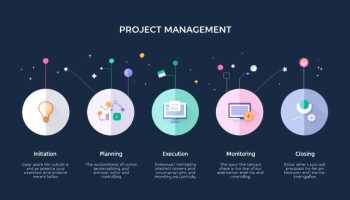
Understanding Acceptance Criteria in Project Management
Acceptance criteria in project management define specific, measurable conditions that determine when stakeholders officially approve a project deliverable. Clear criteria can cut development cycles by 25-30%, eliminate confusion, and align project outcomes with business objectives and user requirements.
Key Takeaways
- Acceptance criteria create a shared understanding of project requirements and success metrics
- Well-defined criteria help reduce risks and prevent costly misinterpretations
- Effective acceptance criteria are clear, concise, testable, and result-oriented
- They serve as a critical tool for controlling scope and improving project communication
- Collaboration between stakeholders is essential in developing meaningful acceptance criteria
Creating detailed acceptance criteria helps teams avoid the common pitfall of scope creep, which affects nearly 52% of projects according to recent industry research. These criteria function as a contract between stakeholders, establishing expectations before work begins.
You’ll find acceptance criteria particularly valuable for complex projects where multiple interpretations might exist. They transform abstract requirements into concrete, testable statements that leave little room for confusion. When writing these criteria, focus on the end result rather than implementation details.
Teams should update acceptance criteria throughout the project lifecycle as needed. This iterative approach ensures that changing business needs don’t compromise project success.
Effective criteria use simple language that both technical and non-technical stakeholders understand. Each criterion should pass the SMART test: Specific, Measurable, Achievable, Relevant, and Time-bound.
Project managers can incorporate acceptance criteria into user stories with the popular format: “Given [precondition], when [action], then [expected result].” This structure clarifies expectations for developers, testers, and business stakeholders alike.
“Clear and concise acceptance criteria transform project deliverables into measurable success, bridging the gap between stakeholder expectations and tangible outcomes. By fostering collaboration and reducing ambiguity, organizations can streamline development, mitigate risks, and ensure alignment with business goals.”
Understanding Acceptance Criteria in Project Management
Acceptance criteria in project management are the specific, measurable, and clear conditions that a project deliverable must meet to be considered complete and accepted by stakeholders. They serve as a formal agreement defining what “done” looks like for your projects, tasks, or features. With well-defined acceptance criteria in project management, you can reduce development cycles by 25-30% by avoiding ambiguity and rework while ensuring deliverables satisfy business goals, user needs, and quality standards.
These criteria create clarity and alignment among all stakeholders by establishing a shared understanding of requirements. You’ll find they’re essential for reducing risks of delivering incomplete products by surfacing potential issues early. They also help control scope creep through clear boundaries of what’s included in deliverables.
Effective acceptance criteria share key characteristics that make them valuable for your project:
- Clarity: Easily understandable by all team members
- Conciseness: Conveying necessary information without excessive detail
- Testability: Each condition must be measurable and verifiable
- Result-oriented: Focus on outcomes rather than implementation
- Uniqueness: Specific to each work item or user story
Types and Formats of Acceptance Criteria
You can implement acceptance criteria in project management using different formats depending on your project needs:
Scenario-oriented criteria follow the Given-When-Then structure for complex features:
- Given (precondition)
- When (user action)
- Then (expected outcome)
Rule-based criteria provide concise statements specifying conditions and thresholds, such as “System locks user account after three failed login attempts” or “Search feature handles 10 simultaneous searches returning results within 2 seconds.”
The implementation of proper acceptance criteria facilitates smoother project collaboration by providing clear direction for multi-team projects. You’ll notice improved estimation accuracy and planning through clearly defined deliverable conditions.
When documenting acceptance criteria in project management, you can include them in requirements documents, project scope statements, and contractual agreements. This documentation ensures everyone understands what success looks like before work begins, creating a foundation for effective project communication and stakeholder satisfaction.
Organizations that excel in project management are 40% more likely to meet their strategic goals, a testament to the effectiveness of processes like well-defined acceptance criteria.
www.cio.com
Purpose and Business Value of Acceptance Criteria
Acceptance criteria in project management serve as the foundation for success by creating clarity and alignment among all stakeholders. These criteria establish a shared understanding of requirements, helping you avoid costly misinterpretations that can derail projects. When properly implemented, acceptance criteria can reduce development cycles by 25-30% by eliminating ambiguity and preventing rework.
You’ll find that well-defined acceptance criteria significantly reduce the risks associated with delivering incomplete or unacceptable products. By surfacing potential issues early in the development process, you can address concerns before they become expensive problems. This proactive approach is crucial for implementing effective risk response strategies throughout your project lifecycle.
Controlling scope creep becomes much easier when you’ve established clear boundaries around what is and isn’t included in deliverables. Without defined acceptance criteria in project management, requirements can expand unchecked, threatening deadlines and budgets. The criteria act as a protective mechanism against the natural tendency for projects to grow beyond their original parameters.
Project execution flows more smoothly when teams have precise direction, especially in complex initiatives involving multiple departments. The acceptance criteria create checkpoints that keep everyone aligned with the project’s goals and critical success factors. This alignment proves particularly valuable when coordinating diverse teams with different perspectives and priorities.
Planning and Estimation Benefits
The value of acceptance criteria extends to planning and estimation. Your project timelines become more realistic when based on clearly defined conditions for deliverable acceptance. Teams can better estimate effort when they understand exactly what constitutes “done” for each component.
Consider these key benefits of implementing robust acceptance criteria in your projects:
- Reduced miscommunication between technical and non-technical stakeholders
- Decreased number of change requests after development has begun
- Improved quality of deliverables through clearly defined standards
- Enhanced stakeholder satisfaction due to alignment with expectations
- More accurate progress tracking against defined completion metrics
- Streamlined testing processes with predetermined success measures
Your ability to deliver successful projects hinges on clearly defining what success looks like. Through carefully crafted acceptance criteria, you establish the foundation for effective project execution, stakeholder satisfaction, and business value realization.
Projects with clear acceptance criteria are 30% more likely to be completed on time and within budget.
hbr.org
Key Characteristics of Effective Acceptance Criteria
Well-crafted acceptance criteria in project management serve as your roadmap to success. These criteria establish clear expectations and provide measurable benchmarks that determine when a deliverable is truly complete.
When developing acceptance criteria, you’ll need to ensure they possess these essential characteristics:
- Clarity: Your acceptance criteria must be easily understood by everyone involved in the project. Avoid technical jargon when communicating with non-technical stakeholders, and ensure language is precise enough to prevent misinterpretations. Clear acceptance criteria can prevent common project management mistakes related to miscommunication.
- Conciseness: Keep your criteria focused and brief while still conveying all necessary information. Overly lengthy criteria often introduce ambiguity rather than clarity.
- Testability: Each criterion must be verifiable through specific tests. If you can’t measure it, you can’t confirm it’s been achieved. This directly connects to how you’ll define project success criteria in your planning documents.
- Result-orientation: Focus on outcomes rather than implementation methods. Specify what the deliverable should accomplish, not how it should be built.
- Uniqueness: Effective acceptance criteria are tailored to specific deliverables rather than applying generic standards across different work items.
Balancing Detail and Flexibility
Finding the right level of detail in your acceptance criteria requires careful consideration. Too little detail leaves room for misinterpretation, while too much can stifle creativity and innovation. Your acceptance criteria in project management should:
- Provide enough specificity to guide implementation while allowing for appropriate solution approaches
- Remain adaptable to evolving project conditions without changing core requirements
- Include both functional and non-functional requirements when relevant
- Establish clear boundaries for what is in and out of scope
- Connect directly to business value and user needs
The best acceptance criteria emerge from collaborative discussions between stakeholders, project managers, and delivery teams. This collaboration ensures all perspectives are considered and strengthens project collaboration. When everyone contributes to defining what “done” looks like, the team develops shared ownership of both the criteria and the resulting deliverables.
By establishing clear acceptance criteria, you create a foundation for project success. These criteria serve as your quality gates, helping you maintain focus on what matters most while reducing ambiguity and rework throughout the project lifecycle.

Types and Formats of Acceptance Criteria
When you implement acceptance criteria in project management, you’ll encounter different formats that can be tailored to your specific project needs. Each type serves unique purposes while maintaining the core function of defining what “done” means for your deliverables.
Scenario-oriented acceptance criteria follow the Given-When-Then structure, making them perfect for complex features where user interactions need clear definition. This format creates a mini-story that outlines the precondition, user action, and expected outcome. For example:
- Given a customer has items in their shopping cart
- When they click the “checkout” button
- Then the system should display payment options
Rule-based acceptance criteria work well for straightforward technical requirements where specific conditions must be met. These concise statements specify exact thresholds and behaviors:
- The system must process 500 concurrent users without performance degradation
- Password recovery emails must be delivered within 2 minutes of request
- The application must function correctly in Chrome, Firefox, and Safari browsers
You can document acceptance criteria in various locations depending on your project delivery framework. Common places include requirements documentation, user stories in agile management tools, project scope statements, and contractual agreements with clients or vendors.
Functional vs. Non-Functional Criteria
When developing acceptance criteria in project management, you must address both functional and non-functional aspects of your deliverables:
| Type | Focus | Examples |
|---|---|---|
| Functional | What the system does | User can reset password, Report shows monthly sales figures |
| Non-functional | How the system performs | Page loads in under 3 seconds, System available 99.9% of time |
Non-functional criteria are often overlooked but are crucial for project success criteria and stakeholder satisfaction. They address performance, security, usability, and reliability requirements that determine whether users actually adopt your solution.
Remember that acceptance criteria in project management should be developed collaboratively with stakeholders to ensure everyone agrees on expectations before work begins. This approach helps prevent scope creep and misalignment between what’s delivered and what’s expected.
Expert Insight: When crafting acceptance criteria in project management, leverage both scenario-oriented and rule-based formats to clearly define what “done” looks like for your deliverables. Incorporating functional and non-functional criteria ensures comprehensive coverage of both system capabilities and performance expectations, which is vital for stakeholder satisfaction. Collaborate with stakeholders during the development of these criteria to prevent scope creep and ensure alignment, setting a solid foundation for project success.






